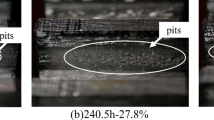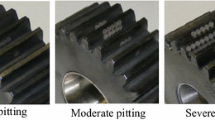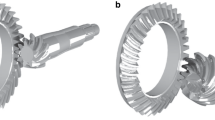Abstract
The research on the time-varying meshing stiffness (TVMS) of gears provides a theoretical basis for the extraction of fault features. Pitting is a common tooth surface fault that has a significant effect on the TVMS. In this paper, a modeling method for evaluating the TVMS of gears with irregular-shaped pitting is proposed to replace the previous modeling methods by which pitting is reduced to simple geometry such as rectangles and cylinders. By the proposed method, the irregular-shaped pitting in analytical models can be matched with that of real objects and 3-D models in CAD software. Firstly, referring to the idea of reverse modeling in reverse engineering, the point cloud is used to map the real objects and 3-D models in CAD software to the analytical models. And a special point cloud processing algorithm is proposed to accurately calculate the TVMS. Then the coupling between multiple teeth with pitting is further investigated. The distribution and expansion of pitting are assumed to be 2-D normal distribution and random expansion. In addition, a complete system is established by taking into account of the gear body structure coupling effect, the nonlinear Hertzian contact stiffness, the accurate transition curve, and the tooth profile modification. Eventually, validation and discussion are conducted and it is demonstrated that the TVMS obtained by the proposed method is largely consistent with that calculated by the finite element method.






























Similar content being viewed by others
References
Sun R-B, Yang Z-B, Yang L-D, Qiao B-J, Chen X-F, Gryllias K (2020) Planetary gearbox spectral modeling based on the hybrid method of dynamics and LSTM. Mech Syst Signal Process 138:106611. https://doi.org/10.1016/j.ymssp.2019.106611
Li X, Shao H, Lu S, Xiang J, Cai B (2022) Highly efficient fault diagnosis of rotating machinery under time-varying speeds using LSISMM and small infrared thermal images. IEEE Trans Syst Man Cybern Syst 52(12):7328–7340. https://doi.org/10.1109/tsmc.2022.3151185
Liu C, Shi W, Liu K (2022) Calculation method of mesh stiffness for helical gear pair with manufacturing errors, assembly errors and tooth modifications. Meccanica 57(3):541–565. https://doi.org/10.1007/s11012-022-01479-8
Parey A, Tandon N (2003) Spur gear dynamic models including defects: a review. Shock Vibr Dig 36(6):465–478. https://doi.org/10.1177/05831024030356002
Marafona JDM, Marques PMT, Martins RC, Seabra JHO (2021) Mesh stiffness models for cylindrical gears: a detailed review. Mech Mach Theory 166:104472. https://doi.org/10.1016/j.mechmachtheory.2021.104472
Feng M, Ma H, Li Z, Wang Q, Wen B (2017) An improved analytical method for calculating time-varying mesh stiffness of helical gears. Meccanica 53(4–5):1131–1145. https://doi.org/10.1007/s11012-017-0746-6
Randall RB (1982) A new method of modeling gear faults. J Mech Des Trans ASME 104(2):259–267. https://doi.org/10.1115/1.3256334
Huang W, Song Z, Zhang C, Wang J, Shi J, Jiang X, Zhu Z (2021) Multi-source fidelity sparse representation via convex optimization for gearbox compound fault diagnosis. J Sound Vib 496:115879. https://doi.org/10.1016/j.jsv.2020.115879
P.J. Blau, ASM Handbook, volume 18 – friction, lubrication, and wear technology, ASM International.
Ding Y, Rieger NF (2003) Spalling formation mechanism for gears. Wear 254(12):1307–1317. https://doi.org/10.1016/s0043-1648(03)00126-1
Ma H, Li Z, Feng M, Feng R, Wen B (2016) Time-varying mesh stiffness calculation of spur gears with spalling defect. Eng Fail Anal 66:166–176. https://doi.org/10.1016/j.engfailanal.2016.04.025
Wang S, Zhu R (2020) An improved mesh stiffness calculation model of spur gear pair under mixed EHL friction with spalling effect. Vib Proced 33:176–181. https://doi.org/10.21595/vp.2020.21671
Luo W, Qiao B, Shen Z, Yang Z, Chen X (2020) Time-varying mesh stiffness calculation of a planetary gear set with the spalling defect under sliding friction. Meccanica 55(1):245–260. https://doi.org/10.1007/s11012-019-01115-y
Chaari F, Baccar W, Abbes MS, Haddar M (2008) Effect of spalling or tooth breakage on gearmesh stiffness and dynamic response of a one-stage spur gear transmission. Eur J Mech A Solids 27(4):691–705. https://doi.org/10.1016/j.euromechsol.2007.11.005
Liang X, Zhang H, Liu L, Zuo MJ (2016) The influence of tooth pitting on the mesh stiffness of a pair of external spur gears. Mech Mach Theory 106:1–15. https://doi.org/10.1016/j.mechmachtheory.2016.08.005
Chen T, Wang Y, Chen Z (2019) A novel distribution model of multiple teeth pits for evaluating time-varying mesh stiffness of external spur gears. Mech Syst Signal Process 129:479–501. https://doi.org/10.1016/j.ymssp.2019.04.029
Lei Y, Liu Z, Wang D, Yang X, Liu H, Lin J (2018) A probability distribution model of tooth pits for evaluating time-varying mesh stiffness of pitting gears. Mech Syst Signal Process 106:355–366. https://doi.org/10.1016/j.ymssp.2018.01.005
Luo Y, Baddour N, Han G, Jiang F, Liang M (2018) Evaluation of the time-varying mesh stiffness for gears with tooth spalls with curved-bottom features. Eng Fail Anal 92:430–442. https://doi.org/10.1016/j.engfailanal.2018.06.010
AFd Rincon, F Viadero, M Iglesias, A de-Juan, P Garcia, R Sancibrian (2012) Effect of cracks and pitting defects on gear meshing. Proceedings of the Institution of Mechanical Engineers, Part C: Journal of Mechanical Engineering Science 226(11): 2805-2815.https://doi.org/10.1177/0954406212437104
Ouyang T, Wang G, Cheng L, Wang J, Yang R (2022) Comprehensive diagnosis and analysis of spur gears with pitting-crack coupling faults. Mech Mach Theory 176:104968. https://doi.org/10.1016/j.mechmachtheory.2022.104968
Meng Z, Wang F, Shi G (2021) A novel evolution model of pitting failure and effect on time -varying meshing stiffness of spur gears. Eng Fail Anal 120:105068. https://doi.org/10.1016/j.engfailanal.2020.105068
El Yousfi B, Soualhi A, Medjaher K, Guillet F (2020) New approach for gear mesh stiffness evaluation of spur gears with surface defects. Eng Fail Anal 116:104740. https://doi.org/10.1016/j.engfailanal.2020.104740
Meng F, Xia H, Zhang X, Wang J (2022) A new tooth pitting modeling method based on matrix equation for evaluating time-varying mesh stiffness. Eng Fail Anal 142:106799. https://doi.org/10.1016/j.engfailanal.2022.106799
Tan CK, Irving P, Mba D (2007) A comparative experimental study on the diagnostic and prognostic capabilities of acoustics emission, vibration and spectrometric oil analysis for spur gears. Mech Syst Signal Process 21(1):208–233. https://doi.org/10.1016/j.ymssp.2005.09.015
Liu W, Zhu R, Zhou W, Shang Y (2021) Probability distribution model of gear time-varying mesh stiffness with random pitting of tooth surface. Eng Fail Anal. https://doi.org/10.1016/j.engfailanal.2021.105782
Yang DCH, Lin JY (1987) Hertzian damping, tooth friction and bending elasticity in gear impact dynamics. J Mech Transm Autom Des 109(2):189–196. https://doi.org/10.1115/1.3267437
Dai H, Long X, Chen F, Xun C (2021) An improved analytical model for gear mesh stiffness calculation. Mech Mach Theory 159:104262. https://doi.org/10.1016/j.mechmachtheory.2021.104262
Ma H, Zeng J, Feng R, Pang X, Wen B (2016) An improved analytical method for mesh stiffness calculation of spur gears with tip relief. Mech Mach Theory 98:64–80. https://doi.org/10.1016/j.mechmachtheory.2015.11.017
Ma H, Pang X, Feng R, Zeng J, Wen B (2015) Improved time-varying mesh stiffness model of cracked spur gears. Eng Fail Anal 55:271–287. https://doi.org/10.1016/j.engfailanal.2015.06.007
Ma H, Feng M, Li Z, Feng R, Wen B (2016) Time-varying mesh characteristics of a spur gear pair considering the tip-fillet and friction. Meccanica 52(7):1695–1709. https://doi.org/10.1007/s11012-016-0502-3
Xie C, Hua L, Lan J, Han X, Wan X, Xiong X (2018) Improved analytical models for mesh stiffness and load sharing ratio of spur gears considering structure coupling effect. Mech Syst Signal Process 111:331–347. https://doi.org/10.1016/j.ymssp.2018.03.037
Xie C, Hua L, Han X, Lan J, Wan X, Xiong X (2018) Analytical formulas for gear body-induced tooth deflections of spur gears considering structure coupling effect. Int J Mech Sci 148:174–190. https://doi.org/10.1016/j.ijmecsci.2018.08.022
Chen Z, Zhou Z, Zhai W, Wang K (2020) Improved analytical calculation model of spur gear mesh excitations with tooth profile deviations. Mech Mach Theory 149:103838. https://doi.org/10.1016/j.mechmachtheory.2020.103838
Sun Z, Chen S, Hu Z, Tao X (2022) Improved mesh stiffness calculation model of comprehensive modification gears considering actual manufacturing. Mech Mach Theory 167:104470. https://doi.org/10.1016/j.mechmachtheory.2021.104470
Zheng X, Hu Y, He Z, Xiao Y, Zhang X (2022) On the extended tooth contact and nonlinear dynamics for spur gears—an analytical model. Mech Mach Theory 175:104958. https://doi.org/10.1016/j.mechmachtheory.2022.104958
Tian XH (2004) Dynamic simulation for system response of gearbox including localized gear faults. University of Alberta, Edmonton, M.S.
Yang Y, Hu N, Tang J, Hu J, Zhang L, Cheng Z (2021) Dynamic analysis for a spur geared rotor system with tooth tip chipping based on an improved time-varying mesh stiffness model. Mech Mach Theory 165:104435. https://doi.org/10.1016/j.mechmachtheory.2021.104435
Jiang H, Liu F (2019) Analytical models of mesh stiffness for cracked spur gears considering gear body deflection and dynamic simulation. Meccanica 54(11–12):1889–1909. https://doi.org/10.1007/s11012-019-01053-9
Xinhua D, Yong M, Qiang, L (2013) Realization method of tooth root transition curve best linetype of involute gear. J Mech Transm 37(5):47–49
He R, Tenberge P, Xu X, Li H, Uelpenich R, Dong P, Wang S (2021) Study on the optimum standard parameters of hob optimization for reducing gear tooth root stress. Mech Mach Theory 156:104128. https://doi.org/10.1016/j.mechmachtheory.2020.104128
Gao P, Liu H, Yan P, Xie Y, Xiang C, Wang C (2022) Research on application of dynamic optimization modification for an involute spur gear in a fixed-shaft gear transmission system. Mech Syst Sig Process 181:109530. https://doi.org/10.1016/j.ymssp.2022.109530
Peng X, Zhou J (2022) Optimization design for dynamic characteristics of face gear drive with surface-active modification. Mech Mach Theory 176:105007. https://doi.org/10.1016/j.mechmachtheory.2022.105007
Hashemian A, Hosseini SF (2018) An integrated fitting and fairing approach for object reconstruction using smooth NURBS curves and surfaces. Comput Math Appl 76(7):1555–1575. https://doi.org/10.1016/j.camwa.2018.07.007
Zhu L, Yan B, Wang Y, Dun Y, Ma J, Li C (2021) Inspection of blade profile and machining deviation analysis based on sample points optimization and NURBS knot insertion. Thin-Walled Struct 162:107540. https://doi.org/10.1016/j.tws.2021.107540
Gonzalez-Perez I, Fuentes-Aznar A (2022) Reverse engineering of spiral bevel gear drives reconstructed from point clouds. Mech Mach Theory 170:104694. https://doi.org/10.1016/j.mechmachtheory.2021.104694
Piegl L, Tiller W (1996) The NURBS book. Springer Science & Business Media
Iman Zolanvari SM, Laefer DF (2016) Slicing Method for curved façade and window extraction from point clouds. ISPRS J Photogramm Remote Sens 119:334–346. https://doi.org/10.1016/j.isprsjprs.2016.06.011
Kassotakis N, Sarhosis V, Riveiro B, Conde B, D’Altri AM, Mills J, Milani G, de Miranda S, Castellazzi G (2020) Three-dimensional discrete element modelling of rubble masonry structures from dense point clouds. Autom Constr 119:103365. https://doi.org/10.1016/j.autcon.2020.103365
Xu Y, Zhang M, Yang S, Zheng B (2021) Measurement and qualification of welded I-column failure mode using laser scanning technique. Structures 34:2694–2707. https://doi.org/10.1016/j.istruc.2021.09.040
Acknowledgements
This work was supported in part by the National Natural Science Foundation of China under Grant 52075470, in part by the Central Government Guides Local Science and Technology Development Foundation under Grant 226Z2101G, in part by the High Level Personnel Funding Project of Hebei Province under Grant A202102001, in part by the Cultivation Project for Basic Research and Innovation of Yanshan University under Grant 2021LGZD006.
Author information
Authors and Affiliations
Corresponding author
Ethics declarations
Conflict of interest
The authors declare that they have no conflict of interest.
Additional information
Publisher's Note
Springer Nature remains neutral with regard to jurisdictional claims in published maps and institutional affiliations.
Rights and permissions
Springer Nature or its licensor (e.g. a society or other partner) holds exclusive rights to this article under a publishing agreement with the author(s) or other rightsholder(s); author self-archiving of the accepted manuscript version of this article is solely governed by the terms of such publishing agreement and applicable law.
About this article
Cite this article
Meng, Z., Hao, G., Pang, X. et al. A novel modeling method for evaluating the time-varying mesh stiffness of gears with pitting based on point cloud processing algorithm. Meccanica 58, 1465–1494 (2023). https://doi.org/10.1007/s11012-023-01674-1
Received:
Accepted:
Published:
Issue Date:
DOI: https://doi.org/10.1007/s11012-023-01674-1




